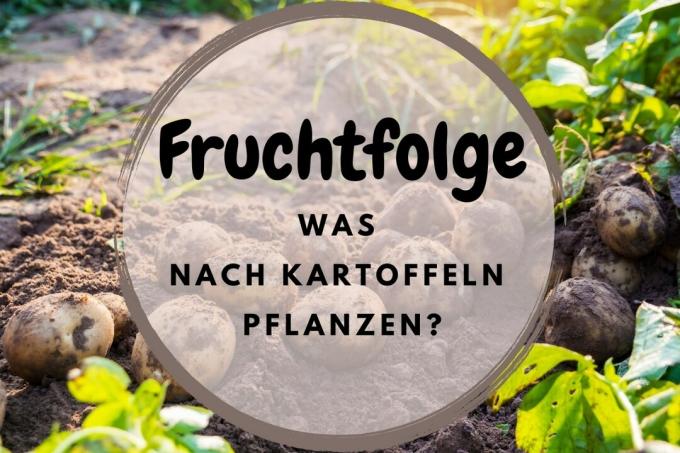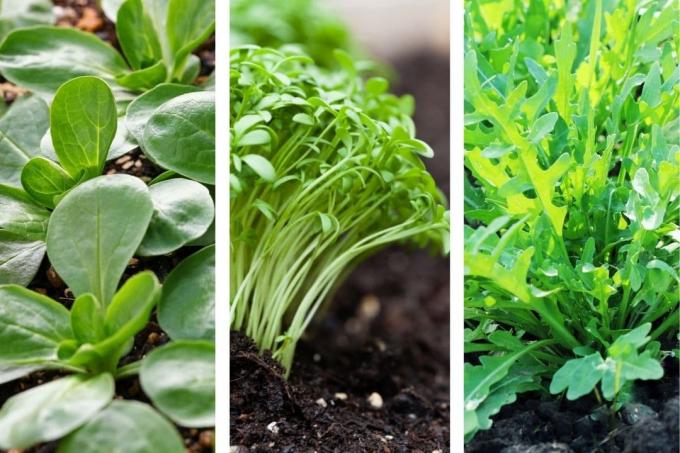
table of contents
- Potatoes unsuitable
- Crop rotation after early potatoes
- Crop rotation after late potatoes
- frequently asked Questions
The crop rotation is important in order to make the best possible use of the vegetable patch and to achieve the best possible harvest yields. Especially with potatoes (Solanum tuberosum) there are a few things to consider and the right plants to be planted.
In a nutshell
- Potatoes fall under heavy eaters
- Differences between early and late potatoes
- Never plant potatoes again in the same or the following year
Potatoes unsuitable
Because potatoes as Heavy Eater heavily leaching the soil, potatoes should not be sown again after harvesting. Due to the high nutrient requirement, the soil structure is also reduced during the first sowing, so that a second sowing promises little chance of strong growth. In addition, pests and / or pathogens may have remained in the soil from the potato as a previous crop, which can destroy the subsequent potato cultivation.

Crop rotation after early potatoes
Early potatoes are brought forward in March or sown directly into the vegetable patch in April when the outside temperature is right. June / July is usually harvest time. This creates space in the bed that can still be used for the remaining cultivation season. Now only plant middle eaters. Since the year of cultivation is already well advanced, pre-germination / pre-breeding is recommended for those plants that are to be harvested in late summer or early autumn. But autumn and winter vegetables are also ideal fruit rotors.
Suitable plants for subsequent crops in the same year and with a late harvest time are, for example:
- Chinese cabbage
- fennel
- Kohlrabi
- Swiss chard
- Carrots
- radish
- Salads, such as endive and iceberg lettuce

Tip: Do not plant any other fruiting plants from the nightshade family after potatoes, such as tomatoes, eggplants, and peppers. They are also among the strong eaters and can be attacked by possible potato pests or remaining pathogens.
Crop rotation in the following year
When the new gardening and cultivation season begins, the soil in the bed should already have been well fertilized. This is ideally done with green manure after the last harvest of the bed in the previous year. After the early potatoes have been planted, only weak eaters should be planted in the following years, until, ideally, in the fourth year potatoes and other high eaters can be put back into the bed. These plants, for example, can be planted as weak consumers to succeed a "potato year":
- Beans
- peas
- Lamb's lettuce
- cress
- radish
- arugula
- spinach
- Onions

Crop rotation after late potatoes
Late potatoes are usually harvested in September or October. Many possibilities of sowing with medium or low eaters still in the same year do not remain as a result. Some examples are:
- Autumn spinach
- Winter purses / winter postels

Crop rotation in the following year
Basically, the classic annual plan applies after the cultivation of heavily draining autumn potatoes.
in the second year after growing potatoes, plant only medium eaters. In addition to the above-mentioned middle consumers, you can also choose these:
- Blood vessel
- Chicory
- Strawberries
- garlic
- Bulbous ziest
- leek
-
Lovage
- parsley
- Beetroot
- Runner beans

in the third year After growing potatoes, you only eat poor people. In addition, the following examples are ideal for crop rotation:
- Barbara herb
- Earth chestnuts
- Garden report
- Oat root
- Herbs, such as thyme, Curry herb and sage
- Jerusalem artichoke

Note: The time of the first sowing / planting is always referred to as the first year. This means that the following year automatically becomes the “second year of cultivation”.
frequently asked Questions
Yes, but not in the same year. Even when planting new potatoes, there is not enough time left for the corn to ripen sufficiently in the current year. That is why maize should always be planted or sown the following year after potatoes.
Yes, you can, but you shouldn't. Potatoes that consume a lot of food not only remove an enormous amount of nutrients from the soil, they also “tire” the earth. If it is depleted, it is then not able to absorb nutrients from fertilizers in sufficient quantities and to deliver them to the roots. Fertilizing is always good after the cultivation of heavy eaters, but this is only helpful for subsequent medium or low eaters. Only when the soil has fully recovered after about four years can it be stored again completely in fertilizer.
With all nightshade plants it is kept like with the potatoes: keep a waiting time of three, better four Years after the potato harvest, before you then place any nightshade plants in this place in the bed set.
